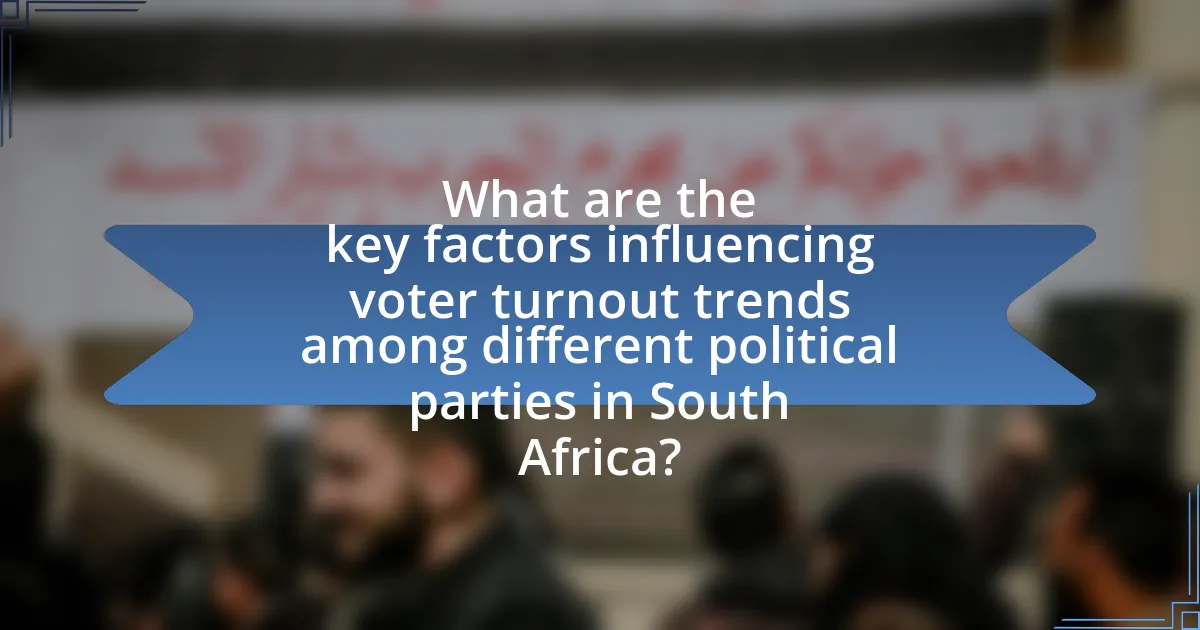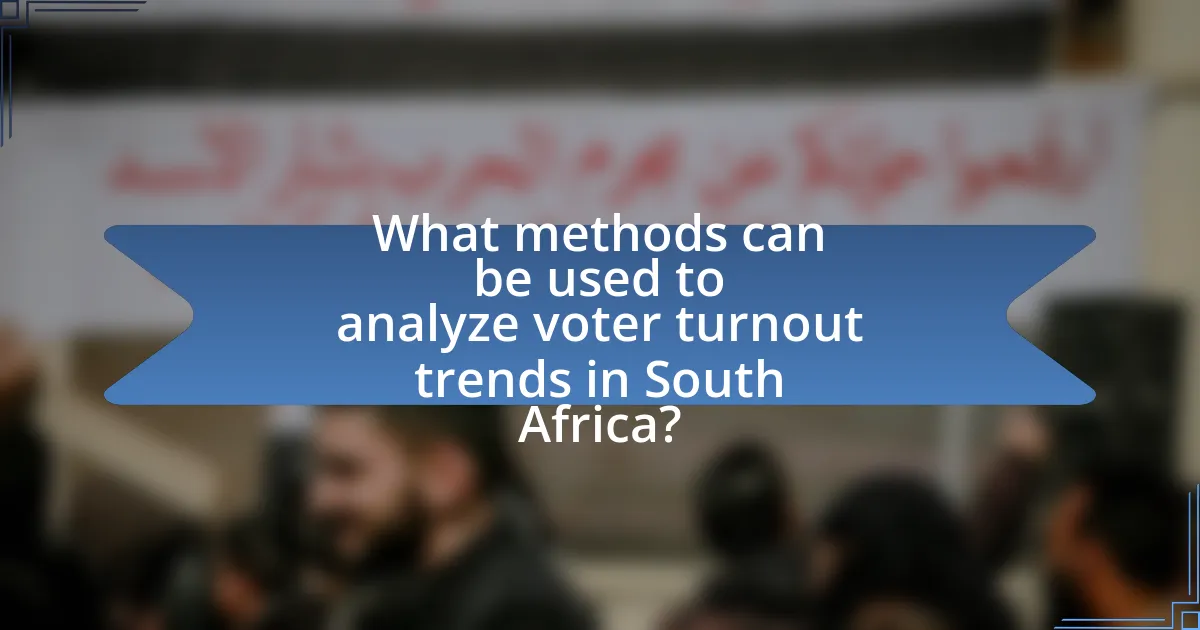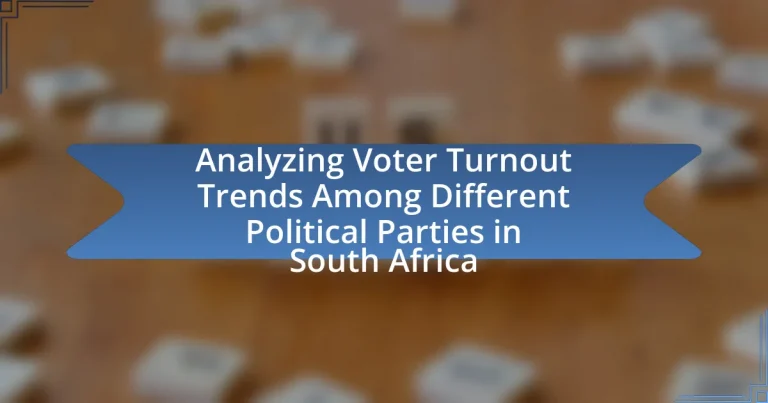The article analyzes voter turnout trends among different political parties in South Africa, focusing on key factors such as socioeconomic status, political engagement, and party loyalty. It examines how demographic elements, including age, race, and education, influence voter participation rates, highlighting disparities between younger and older voters as well as between various income levels. The impact of historical events, particularly the legacy of apartheid, on contemporary voting behavior is also discussed, alongside the strategies employed by major and smaller political parties to mobilize voters. Additionally, the article explores methods for analyzing voter turnout data, emphasizing the importance of education and outreach campaigns in enhancing electoral participation.

What are the key factors influencing voter turnout trends among different political parties in South Africa?
Key factors influencing voter turnout trends among different political parties in South Africa include socioeconomic status, political engagement, and party loyalty. Socioeconomic status significantly affects turnout, as individuals with higher income and education levels tend to vote more frequently. For instance, the 2019 national elections showed that urban voters, who generally have better access to resources and information, participated at higher rates than rural voters. Political engagement, including the effectiveness of party campaigns and mobilization efforts, also plays a crucial role; parties that actively engage with their constituents often see higher turnout. Additionally, party loyalty influences turnout, as established parties like the African National Congress maintain a strong base, while newer parties struggle to mobilize voters. These factors collectively shape the dynamics of voter participation across different political affiliations in South Africa.
How do demographic factors affect voter turnout in South Africa?
Demographic factors significantly affect voter turnout in South Africa, with age, race, education, and socioeconomic status being key influences. Younger voters, particularly those aged 18-24, tend to have lower turnout rates compared to older age groups, as evidenced by the 2019 national elections where only 50% of eligible voters in this age bracket participated. Racial dynamics also play a crucial role; historically marginalized groups, such as Black South Africans, show varying turnout rates influenced by historical disenfranchisement and current socio-economic challenges. Education levels correlate positively with voter turnout; individuals with higher education are more likely to vote, as seen in studies indicating that educated voters participated at rates exceeding 80%. Additionally, socioeconomic status impacts engagement, with wealthier individuals generally exhibiting higher turnout rates due to better access to resources and information. These demographic factors collectively shape the electoral landscape in South Africa, influencing the participation rates across different political parties.
What role does age play in voter turnout among political parties?
Age significantly influences voter turnout among political parties in South Africa, with younger voters typically exhibiting lower participation rates compared to older demographics. Research indicates that individuals aged 18 to 24 have historically shown the lowest turnout, often due to factors such as lack of engagement, mobility, and disillusionment with the political process. In contrast, voters aged 55 and above tend to participate at higher rates, driven by a stronger sense of civic duty and established voting habits. For instance, the Electoral Commission of South Africa reported in the 2019 elections that voter turnout for those aged 18-24 was approximately 26%, while turnout for those aged 55 and older reached around 60%. This age-related disparity in turnout can significantly affect the electoral outcomes and the representation of political parties, as older voters may have different priorities and preferences compared to younger voters.
How does education level influence voter participation?
Education level significantly influences voter participation, with higher educational attainment correlating to increased likelihood of voting. Studies indicate that individuals with tertiary education are more likely to engage in electoral processes compared to those with lower educational backgrounds. For instance, data from the Electoral Commission of South Africa shows that in the 2019 national elections, voter turnout was approximately 80% among individuals with a university degree, while it dropped to around 50% for those with only a high school education. This trend suggests that education enhances political awareness, civic engagement, and the ability to navigate the voting process, thereby increasing participation rates.
What impact do socio-economic factors have on voter turnout?
Socio-economic factors significantly influence voter turnout by affecting individuals’ access to resources, education, and civic engagement. For instance, individuals with higher income levels and educational attainment are more likely to participate in elections, as evidenced by studies showing that voter turnout rates are approximately 20% higher among college graduates compared to those with only a high school diploma. Additionally, socio-economic status impacts the ability to navigate the voting process, with lower-income individuals facing barriers such as transportation issues and time constraints due to work obligations. Research conducted by the Electoral Commission of South Africa indicates that socio-economic disparities contribute to lower turnout rates among marginalized communities, highlighting the correlation between economic stability and electoral participation.
How does income level correlate with voter turnout rates?
Income level positively correlates with voter turnout rates, as higher income individuals tend to participate more in elections. Studies indicate that individuals with higher incomes are more likely to vote due to factors such as greater access to information, resources for mobilization, and a stronger sense of civic duty. For instance, data from the 2019 South African Electoral Commission report shows that voter turnout among the highest income bracket was approximately 80%, compared to around 50% for the lowest income bracket. This trend highlights the significant impact of economic status on electoral participation in South Africa.
What is the effect of employment status on voting behavior?
Employment status significantly influences voting behavior, as employed individuals tend to vote at higher rates compared to unemployed individuals. Research indicates that job stability often correlates with a greater sense of civic responsibility and engagement in political processes. For instance, a study by the Pew Research Center found that employed voters are more likely to participate in elections, with a turnout rate of approximately 70% compared to around 50% for those unemployed. This disparity can be attributed to factors such as economic security, access to resources, and social networks that facilitate political participation.
How do historical events shape current voter turnout trends?
Historical events significantly influence current voter turnout trends by shaping political engagement and public trust in the electoral process. For instance, the end of apartheid in South Africa in 1994 marked a pivotal moment that mobilized previously disenfranchised populations, resulting in a historic voter turnout of 86.9% in the first democratic elections. This event established a precedent for high participation rates among marginalized communities, which continues to affect turnout today. Additionally, subsequent events, such as the Marikana massacre in 2012, have impacted public sentiment and trust in political institutions, leading to fluctuations in voter engagement. Studies indicate that historical grievances and milestones create a legacy that informs contemporary political behavior, as seen in the varying turnout rates among different demographic groups in South Africa.
What significant elections have influenced voter turnout patterns?
The significant elections that have influenced voter turnout patterns in South Africa include the 1994 general elections, which marked the end of apartheid and saw a historic turnout of 86.9%, and the 2014 general elections, where turnout was 73.4%. The 1994 elections were pivotal as they represented the first democratic vote for all citizens, leading to unprecedented engagement. In contrast, the 2014 elections reflected a decline in enthusiasm, attributed to voter apathy and disillusionment with political parties. These elections serve as key indicators of how historical context and political climate can shape voter participation in South Africa.
How does the legacy of apartheid affect contemporary voting behavior?
The legacy of apartheid significantly influences contemporary voting behavior in South Africa by perpetuating racial divisions and socio-economic disparities. Historical disenfranchisement of non-white populations has led to a persistent alignment of voting patterns along racial lines, with the African National Congress (ANC) receiving strong support from black voters while other parties, such as the Democratic Alliance (DA), attract predominantly white and colored voters. According to the 2021 South African Census, 55% of black South Africans reported voting for the ANC, reflecting the party’s historical ties to the anti-apartheid struggle. Additionally, socio-economic factors rooted in apartheid, such as poverty and education disparities, continue to shape voter preferences and turnout, as marginalized communities often face barriers to political participation. This ongoing impact of apartheid’s legacy underscores the complexities of South Africa’s electoral landscape and the enduring significance of race in shaping political affiliations.

What are the differences in voter turnout among major political parties in South Africa?
Voter turnout in South Africa varies significantly among major political parties, with the African National Congress (ANC) historically experiencing the highest turnout, followed by the Democratic Alliance (DA) and the Economic Freedom Fighters (EFF). In the 2019 national elections, the ANC secured approximately 57% of the votes, while the DA garnered around 22% and the EFF received about 10%. This disparity indicates that the ANC has maintained a strong voter base, although its turnout has declined from previous elections, reflecting a trend of decreasing support. The DA and EFF, while having lower overall turnout, have shown growth in their voter bases, particularly among younger demographics and urban areas. This data illustrates the differences in voter engagement and support levels among South Africa’s major political parties.
Which political parties have the highest voter turnout rates?
The African National Congress (ANC) has historically had the highest voter turnout rates among political parties in South Africa. In the 2019 national elections, the ANC received approximately 57.5% of the votes, reflecting strong voter engagement. This trend is supported by data from the Electoral Commission of South Africa, which indicates that the ANC consistently mobilizes a significant portion of the electorate compared to other parties. The Democratic Alliance (DA) and the Economic Freedom Fighters (EFF) follow, but their turnout rates are notably lower, with the DA securing around 21.5% and the EFF about 10.8% in the same election.
What strategies do these parties employ to mobilize voters?
Political parties in South Africa employ various strategies to mobilize voters, including grassroots campaigning, targeted messaging, and leveraging social media. Grassroots campaigning involves engaging local communities through door-to-door outreach, community meetings, and events to build personal connections and trust. Targeted messaging focuses on addressing specific issues relevant to different demographic groups, ensuring that the party’s platform resonates with voters’ concerns. Additionally, social media platforms are utilized to reach a broader audience, disseminate information quickly, and encourage voter participation through online campaigns. These strategies are supported by data indicating that personal engagement and tailored communication significantly enhance voter turnout, as evidenced by the increased participation rates observed in recent elections when these methods were effectively implemented.
How do party ideologies influence voter engagement?
Party ideologies significantly influence voter engagement by shaping the beliefs, values, and priorities that resonate with potential voters. For instance, in South Africa, the African National Congress (ANC) promotes a platform centered on social justice and equality, which mobilizes voters who prioritize these issues. Conversely, the Democratic Alliance (DA) emphasizes economic growth and individual freedoms, attracting voters who value liberal economic policies. Research indicates that ideological alignment between parties and voters enhances engagement; a study by the Electoral Institute for Sustainable Democracy in Africa found that voters are more likely to participate in elections when they feel their beliefs align with the party’s platform. This alignment fosters a sense of connection and urgency, driving higher voter turnout among those who identify with specific ideologies.
What are the trends in voter turnout for smaller political parties?
Voter turnout for smaller political parties in South Africa has shown a declining trend in recent elections. For instance, in the 2019 national elections, smaller parties collectively received approximately 10% of the total vote, a decrease from around 13% in the 2014 elections. This decline can be attributed to several factors, including the dominance of larger parties like the African National Congress and the Democratic Alliance, which overshadow smaller parties in terms of visibility and resources. Additionally, voter apathy and strategic voting, where voters opt for larger parties to avoid “wasting” their votes, further contribute to the reduced turnout for smaller political entities.
How do smaller parties attract voters compared to larger parties?
Smaller parties attract voters compared to larger parties by focusing on niche issues, personalized campaigning, and grassroots mobilization. These parties often address specific concerns that resonate with particular demographics, such as environmental issues or local governance, which larger parties may overlook. For instance, in South Africa, smaller parties like the Economic Freedom Fighters have successfully engaged younger voters by advocating for land reform and economic equality, issues that are particularly relevant to this demographic. Additionally, smaller parties typically employ more direct and personal outreach strategies, such as community meetings and social media engagement, which can create a stronger connection with voters. This approach contrasts with larger parties that may rely on broader, less targeted messaging.
What challenges do smaller parties face in increasing voter turnout?
Smaller parties face significant challenges in increasing voter turnout, primarily due to limited resources and visibility. These parties often lack the financial backing and media exposure that larger parties enjoy, which restricts their ability to effectively communicate their platforms and mobilize supporters. For instance, according to the Electoral Commission of South Africa, smaller parties received only 5% of the total campaign funding in the 2019 elections, making it difficult for them to reach potential voters. Additionally, smaller parties struggle with name recognition and voter loyalty, as many voters may perceive them as less viable options compared to established parties. This perception can lead to lower engagement and turnout among their potential supporters.
How does party loyalty affect voter turnout in South Africa?
Party loyalty significantly enhances voter turnout in South Africa. Research indicates that individuals who identify strongly with a political party are more likely to participate in elections, as evidenced by the African National Congress (ANC) consistently achieving higher voter turnout rates compared to other parties. For instance, in the 2019 national elections, the ANC garnered approximately 57% of the votes, reflecting the strong loyalty of its supporters. This loyalty is often rooted in historical, cultural, and socio-economic factors, which further solidify the commitment of voters to their chosen party. Consequently, party loyalty serves as a crucial determinant of electoral participation in South Africa.
What factors contribute to strong party loyalty among voters?
Strong party loyalty among voters is primarily influenced by social identity, political socialization, and party performance. Social identity theory suggests that individuals align with political parties that reflect their social groups, such as ethnicity or socioeconomic status, fostering a sense of belonging. Political socialization, which occurs through family, education, and media, shapes voters’ perceptions and attachments to specific parties from a young age. Additionally, party performance, including the effectiveness of policies and governance, significantly impacts loyalty; voters are more likely to remain loyal to parties that they perceive as delivering on their promises and improving their lives. For instance, in South Africa, the African National Congress has maintained a strong voter base partly due to its historical significance and ongoing efforts to address issues like inequality and unemployment.
How does disillusionment with parties impact voter turnout?
Disillusionment with political parties significantly decreases voter turnout. When voters feel disconnected or dissatisfied with party platforms, leadership, or perceived corruption, they are less likely to participate in elections. For instance, research conducted by the Electoral Commission of South Africa in 2021 indicated that 40% of respondents cited a lack of trust in political parties as a primary reason for not voting. This trend shows that as disillusionment grows, engagement in the electoral process diminishes, leading to lower overall turnout rates.

What methods can be used to analyze voter turnout trends in South Africa?
Methods to analyze voter turnout trends in South Africa include statistical analysis, surveys, and historical comparison. Statistical analysis involves examining electoral data to identify patterns and correlations, such as demographic factors influencing turnout. Surveys can gather qualitative data on voter motivations and barriers, providing insights into why certain groups may participate more or less in elections. Historical comparison allows researchers to evaluate changes in turnout over time, assessing the impact of political events, legislation, and socio-economic factors. These methods collectively enhance understanding of voter behavior and trends in South Africa’s electoral landscape.
What data sources are available for analyzing voter turnout?
Data sources available for analyzing voter turnout include national electoral commissions, academic research studies, and public opinion surveys. National electoral commissions, such as the Electoral Commission of South Africa, provide official statistics on voter registration and turnout rates for each election. Academic research studies often analyze historical voting patterns and demographic influences on turnout, utilizing datasets from sources like the South African Social Attitudes Survey. Public opinion surveys, conducted by organizations like Ipsos or the Human Sciences Research Council, gather insights on voter motivations and barriers to participation, offering qualitative data that complements quantitative turnout statistics.
How do electoral commission reports contribute to understanding turnout trends?
Electoral commission reports provide critical data that helps analyze voter turnout trends by offering detailed statistics on participation rates across different demographics and elections. These reports typically include information on the number of registered voters, actual votes cast, and turnout percentages, which allow researchers and analysts to identify patterns over time. For instance, the Electoral Commission of South Africa’s reports from various elections reveal fluctuations in turnout among different political parties, highlighting shifts in voter engagement and preferences. This data is essential for understanding the factors influencing voter behavior, such as socioeconomic status, geographic location, and political climate, thereby enabling a comprehensive analysis of turnout trends in the context of South Africa’s evolving political landscape.
What role do surveys and polls play in analyzing voter behavior?
Surveys and polls are essential tools for analyzing voter behavior as they provide quantitative data on public opinion and preferences. These instruments capture the attitudes, motivations, and demographics of voters, allowing researchers to identify trends and patterns in electoral participation. For instance, a study by the Electoral Commission of South Africa in 2021 revealed that surveys indicated a significant correlation between socioeconomic status and voter turnout, highlighting how different political parties attract varying voter demographics. By analyzing this data, political analysts can better understand the factors influencing voter decisions and turnout rates among different political parties in South Africa.
How can statistical methods be applied to study voter turnout?
Statistical methods can be applied to study voter turnout by analyzing data sets that include demographic information, voting history, and election results. Researchers can use descriptive statistics to summarize turnout rates across different political parties and demographic groups, revealing patterns and trends. For instance, logistic regression can model the likelihood of voting based on variables such as age, education, and income, allowing for the identification of factors that significantly influence voter participation. Additionally, inferential statistics can be employed to generalize findings from sample data to the broader population, providing insights into how various factors affect turnout rates among different political parties in South Africa. Historical data from past elections can also be analyzed to track changes in voter turnout over time, offering a comprehensive view of electoral engagement.
What statistical techniques are most effective for analyzing turnout data?
Regression analysis is one of the most effective statistical techniques for analyzing turnout data. This method allows researchers to identify relationships between voter turnout and various independent variables, such as demographic factors, socioeconomic status, and political affiliation. For instance, logistic regression can be particularly useful when the dependent variable is binary, such as whether an individual voted or not. Additionally, time series analysis can help in understanding trends over multiple election cycles, revealing patterns in voter behavior. These techniques are validated by numerous studies, including those that have analyzed turnout data in South Africa, demonstrating their effectiveness in providing insights into electoral participation across different political parties.
How can regression analysis help in understanding voter turnout trends?
Regression analysis can help in understanding voter turnout trends by quantifying the relationship between various factors and voter participation rates. This statistical method allows researchers to identify significant predictors of turnout, such as socioeconomic status, education level, and age demographics. For instance, a study analyzing South African elections found that higher education levels correlate with increased voter turnout, demonstrating how regression can reveal underlying patterns in electoral behavior. By applying regression models, analysts can also forecast future turnout based on historical data, providing insights into how changes in political climate or policy may influence voter engagement.
What practical steps can be taken to improve voter turnout among different political parties?
To improve voter turnout among different political parties in South Africa, parties can implement targeted outreach programs that engage specific demographics. For instance, utilizing social media campaigns can effectively reach younger voters, as studies show that 70% of South African youth are active on platforms like Facebook and Twitter. Additionally, organizing community events and town hall meetings can foster direct engagement, allowing parties to address local issues and concerns, which has been shown to increase voter participation by up to 15%. Furthermore, simplifying the registration process and providing assistance in multiple languages can remove barriers for marginalized communities, as evidenced by the 2019 elections where increased accessibility led to a 5% rise in voter turnout among previously underrepresented groups.
What outreach strategies can political parties implement to engage voters?
Political parties can implement various outreach strategies to engage voters, including grassroots campaigning, digital engagement, and community events. Grassroots campaigning involves mobilizing local volunteers to connect with voters through door-to-door canvassing and phone banking, which has been shown to increase voter turnout significantly. Digital engagement strategies, such as targeted social media advertising and email campaigns, allow parties to reach younger demographics effectively; for instance, a study by the Pew Research Center indicates that 69% of adults aged 18-29 use social media to engage with political content. Additionally, hosting community events, such as town halls and public forums, fosters direct interaction between candidates and constituents, enhancing voter trust and participation. These strategies collectively contribute to higher voter engagement and turnout, particularly in diverse electoral landscapes like South Africa.
How can education and awareness campaigns enhance voter participation?
Education and awareness campaigns can enhance voter participation by informing citizens about the electoral process, their rights, and the importance of their vote. These campaigns often utilize targeted messaging to address specific demographics, thereby increasing engagement among underrepresented groups. For instance, research from the Electoral Commission of South Africa indicates that educational initiatives have led to a measurable increase in voter turnout, particularly among young voters and first-time voters, who may lack familiarity with the voting process. By providing clear information and resources, these campaigns empower individuals to participate actively in elections, ultimately contributing to a more representative democracy.


